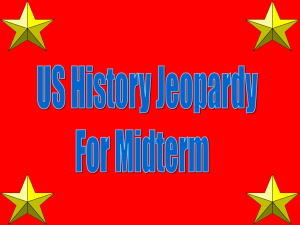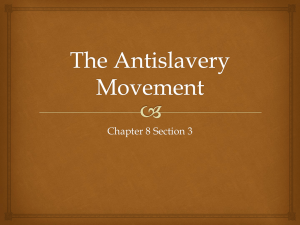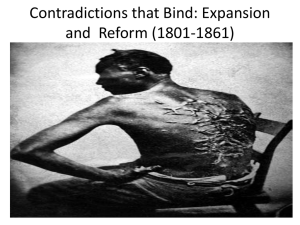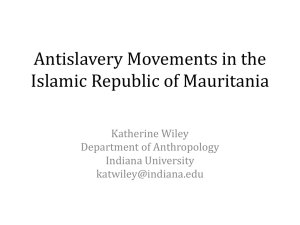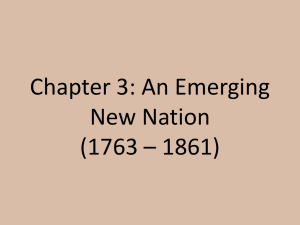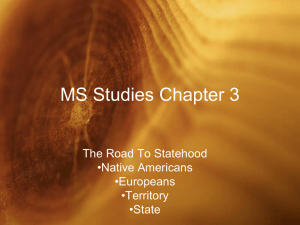Document
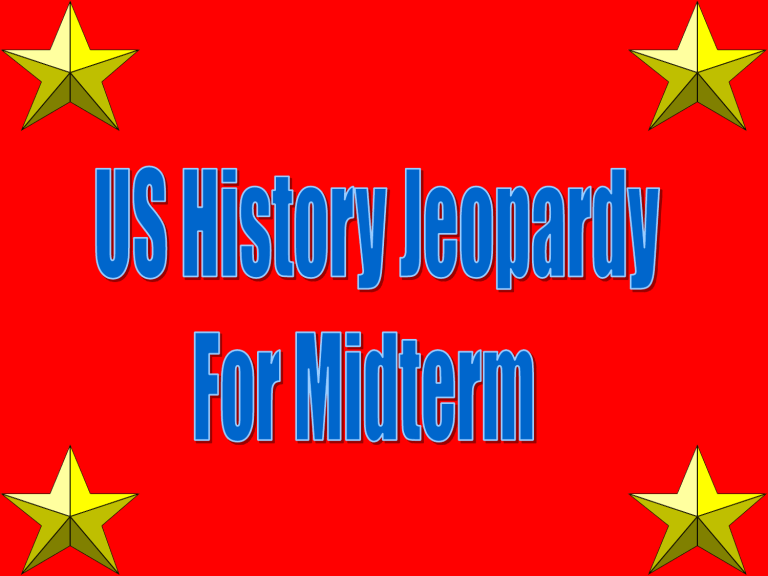
Stocking
Stuffers
Ms.
Barton’s
Gift to You
Don’t Do This
Or This
Especially
Not This
Feds for 1
In February of 1861, the seven seceded states met in
Montgomery, Alabama, to
A) found the Confederate States of America.
B) discuss military strategy after the victory at First Bull
Run.
C) decide how resources would be divided between the seven states of the Confederacy.
D) try to get Arkansas, North Carolina, Virginia, and
Tennessee to join the Confederacy.
Check Your Answer
Feds for 1 a. In February of 1861, the seven seceded states met in Montgomery,
Alabama to found the Confederate
States of America. While
Montgomery was the first capital of the Confederacy, it was soon moved to Richmond, Virginia.
Feds for 2
The Confederate states' most important advantage entering the Civil War is generally considered to be that
A) their Navy was almost twice the size as that of the Union.
B) the South was much more industrial than the North and therefore produced more weapons.
C) their soldiers knew how to ride horses and use firearms better than any northerners did.
D) they only had to fight a defensive war and outlast the
Union's will to fight in order to win.
Check Your Answer
Feds for 2 d. For the most part, the Confederates only had to fight a defensive war and outlast the Union's will to fight in order to win. This was their greatest advantage. In fact, the turning point of the war was when they abandoned this practice and unsuccessfully invaded northern territory.
Feds for 3
In the period before the Civil War, the principle of popular sovereignty meant that whether or not a territory allowed slavery would be left up to
A) territorial legislatures.
B) the United States Senate.
C) the United States Supreme Court.
D) the President most recently elected.
Check Your Answer
Feds for 3 a. The principle of popular sovereignty meant that whether or not a territory allowed slavery would be left up to territorial legislatures.
This was yet another attempt to settle the slavery issue once and for all. Guess what?
It failed MISERABLY, too!
Feds for 4
The Confederate states' most important advantage entering the Civil War is generally considered to be that
A) their Navy was almost twice the size as that of the Union.
B) the South was much more industrial than the North and therefore produced more weapons.
C) their soldiers knew how to ride horses and use firearms better than any northerners did.
D) they only had to fight a defensive war and outlast the
Union's will to fight in order to win.
Check Your Answer
Feds for 4 d. For the most part, the Confederates only had to fight a defensive war and outlast the Union's will to fight in order to win. This was their greatest advantage. In fact, the turning point of the war was when they abandoned this practice and unsuccessfully invaded northern territory.
Feds for 5
During Reconstruction, the Black Codes
A) protected the Constitutional rights and liberties of freed slaves.
B) forced Congress to do the bidding of former Confederate politicians.
C) were enacted by the Radical Republicans to prevent racial discrimination in the South.
D) were laws passed by mainly Southern states to keep African
Americans in a system of virtual slavery.
Check Your Answer
Feds for 5 d. Black Codes were instituted on a state level and were passed by mainly Southern states to keep African Americans in a system of virtual slavery.. These are NOT the same things as “Jim
Crow” laws, which were brought to bear at the end of the 19th century.
Turf for 1
Which area on the map represents the region where sharecropping was the dominant form of agricultural production in the late-1800s?
A)
B)
C)
D)
Check Your Answer
Turf for 1 c. Following the Civil War and the end of slavery, sharecropping became the dominant system of agriculture in the Southeast, region C on the map. This was replaced the system of slavery, and while the African American farmers might have been "free" their rights were still severely limited as to where they could farm and if they could own land.
Turf for 2
"The right of citizens of the United States to vote shall not be denied or abridged by the United States or by any State on account of race, color, or previous condition of servitude."
Fifteenth Amendment to the United States Constitution amendment was created primarily for the purpose of
A) punishing southern states.
B) avoiding another Civil War.
C) pardoning Confederate veterans.
D) granting former slaves suffrage.
This
Check Your Answer
Turf for 2 d. The Thirteenth, Fourteenth, and Fifteenth Amendments all deal with issues that surrounded the Civil War. The fifteenth Amendment was created to allow all people, regardless of race or ‘previous condition of servitude’
(slavery), the right to vote-suffrage, though many states found ways to deny this right for the next one hundred years.
Turf for 3
The Fourteenth Amendment to the Constitution was ratified following which war?
A)
Civil War
B)
Vietnam War
C)
World War II
D)
American Revolution
Check Your Answer
Turf for 3 a. The states in the Southern United
States did not vote to ratify the amendment because it provided equal protection for all citizens of the United
States—including those who were former slaves. The Fourteenth Amendment was ratified right after the Civil War.
Turf for 4
The purpose of the Freedman’s Bureau was to
A) provide 40 acres and a mule for each slave.
B) gain the vote for millions of former slaves.
C) provide work, education, and relief for former slaves.
D) get radical Republicans in positions of power in the South
Check Your Answer
Turf for 4 c. The Freedman’s Bureau was created in
March of 1865 to provide work, education, and relief for former slaves.
While the intentions were good, it ended up being only modestly effective in the south due to lingering prejudices in the local governments there.
Turf for 5
Accounting for almost 60% of American exports by the beginning of the Civil War, which statement regarding the impact of cotton is TRUE?
A)
The Northern states provided the labor for the cotton plantations.
B)
The Southern states developed the plantation system and rigid social classes.
C)
The invention of the cotton gin reduced the South's dependency on cotton farming.
D)
The cotton production fueled the rise of manufacturing centers in the Southern states.
Check Your Answer
Turf for 5 b. Accounting for almost 60% of American exports by the Civil War, the growing of cotton in the Southern states developed the plantation system and rigid social classes. The invention of Whitney's cotton gin increased the South's dependency on cotton farming, much of which was sent to Great Britain's manufacturing centers.
Antebellum for 1
Which is an example of the concept of Manifest Destiny in action?
A) the Compromise of 1850
B) the Missouri Compromise
C) the Transatlantic Slave Trade
D) the annexation of Mexican territory
Check Your Answer
Antebellum for 1
d. Since "Manifest Destiny" was the belief that the U.S. was ordained by God to spread to the Pacific Ocean, the annexation of Mexican territory is the best answer here.
The other issues deal with slavery or slavery in the territories of the United States.
Antebellum for 2
Lucretia Mott and Elizabeth Cady Stanton organized a national meeting at Seneca Falls in 1848. The primary purpose of this convention was to organize the
A) abolition movement.
B) temperance movement.
C) women's suffrage movement.
D)
Native American assistance movement.
Check Your Answer
Antebellum for 2
c. While they did have decidedly anti-slavery opinions, Mott and Stanton were key figures in the women’s suffrage movement.. The Seneca
Falls Convention was meant to unify the women’s movement, and though this was successful it would take roughly another seventy years to accomplish their ultimate goal of women’s suffrage.
Antebellum for 3
Which technological development led to an increased demand for slaves in the United States during the early- to mid-1800s?
A) the steel plow
B) the cotton gin
C) the mechanical reaper
D) the combine harvester
Check Your Answer
Antebellum for 3
b. The technological breakthrough that led to an increased demand for slaves in the early to mid
1800's was the cotton gin. Since the gin quickly and easily separated the cotton fibers from the seeds, plantation owners were able to increase their rate of production which resulted in greater demand for slaves to work in the fields.
Antebellum for 4
In the early 1800s, many people in the United States migrated westwards because
A) of the growing timber industry.
B) of the availability of farmland.
C) transportation was easy thanks to the Transcontinental
Railroad.
D) they wanted to escape slavery, which was illegal in western territories.
Check Your Answer
Antebellum for 4
b. Though the journey west was dangerous and long, many people went. Farmland in the east was scarce an expensive: relatively few people owned most of it. The lure of the availability of farmland out west was attractive to a still predominantly agrarian population. The settling of western lands was part of the U.S.'s
"Manifest Destiny."
Antebellum for 5
Which event is the BEST example of a conflict over states' rights?
A)
Trail of Tears
B)
The War of 1812
C)
Nullification Crisis
D)
Election of Andrew Jackson
Check Your Answer
Antebellum for 5
c. From the choices provided, the Nullification
Crisis is the best example of a conflict over states' rights. Southerners were impacted negatively by the protective tariffs while the
North benefited economically. John C. Calhoun's nullitication theory questioned the legality of applying some federal laws in soverign states.
South Carolina nullified the tariff and threatened to secede from the Union.
House for 1
· Frederick Douglass
· William Lloyd Garrison
· Sojourner TruthAll of these were prominent names were figures in WHICH social movement?
A) abolition
B) prohibition
C) states rights
D) prison reform
Check Your Answer
House for 1 a. All of these people were major figures in the abolition movement. Douglass and Truth were both former slaves who spoke of the evil's of slavery. Garrison was a journalist who founded the abolitionist newspaper The
Liberator .
House for 2
Which of these BEST describes the efforts of William
Lloyd Garrison?
A) organized an unsuccessful slave revolt in 1826.
B) advocated the settling of Liberia by freed slaves.
C) advocated for educational reform in rural areas of the
U.S.
D) urged immediate emancipation of slaves in the United
States.
Check Your Answer
House for 2 d. Garrison founded
The Liberator
in 1831, with an anti-slavery message. Rather than suggest a gradual elimination of of slavery, he urged immediate emancipation of slaves in the United
States. His fiery abolitionist sentiments were somewhat unusual for the day, especially given the fact that he was not an African-American
.
House for 3
Which BEST describes the social and political philosophy of the Underground Railroad “conductor” Harriet
Tubman?
A)
Slavery should be tolerated until legal abolition.
B)
Slavery should only be allowed in states with economic need.
C)
Slaves should be given the opportunity to purchase their own freedom.
D)
Slaves should escape slavery using whatever means were available to them.
Check Your Answer
House for 3
D) Harriet Tubman was a conductor on the Underground
Railroad, which means that she thought slaves should escape slavery using whatever means were available to them. She helped more than seventy African Americans escape slavery using the same rural pathways and chain of hiding places that she herself had used to escape to the North.
House for 4
Who was the most vocal opponent of the Tariff of 1828 and advocated "State's Rights" and "Nullification" in the growing sectional conflicts between North and South?
A)
Henry Clay of Kentucky
B)
Andrew Jackson of Tennessee
C)
Daniel Webster of Massachusetts
D)
John C. Calhoun of South Carolina
Check Your Answer
House for 4 d. The most vocal opponent of the Tariff of 1828 was John C. Calhoun of South Carolina. In
1832, Calhoun resigned as Vice President in order to become South Carolina's representative in the Senate, a position from which he could argue and advocate for slavery, "State's Rights" and "Nullification."
House for 5
Angelina and Sarah Grimke were sisters from South
Carolina and are MOST notable as being 19th century
A) abolitionists.
B) businesswomen.
C) politicians.
D) suffragettes.
Check Your Answer
House for 5 a. The Grimke sisters were unique not merely because they were abolitionists but because they were from South Carolina. Despite their good intentions, many in the north criticized them because they spoke to men AND women during their abolitionist speeches, which was considered inappropriate for that era.
Yanks 1
In 1860, the southern states highlighted in red would have been LEAST likely to
A) use forced labor in its agricultural production.
B) vote for Abraham Lincoln for President of the United
States.
C) push for expansion of slavery in western states and territories.
D) support the notion of
"popular sovereignty" in the debate over slavery.
Check Your Answer
Yanks 1
b. The areas in red are the Confederate States of
America, so they would NOT have voted for Abraham
Lincoln for President of the United States in 1860. In fact, he did not even appear on the ballot in many southern states.
Yanks for 2
Which Civil War battle was significant in that the Union army was able to halt Robert E. Lee's invasion of the north?
A)
Fredericksburg
B)
Gettysburg
C)
Shiloh
D)
Trenton
Check Your Answer
Yanks for 2
b. The Battle of Gettysburg in the summer of 1863 was a major victory for the Union forces commanded by General
George Meade. It is viewed by many historians as "the turning point of the war," and it is significant because the three day battle ended in a resounding victory for the
Union army. Robert E. Lee's forces suffered staggering casualties and the Confederate army was driven out of
Pennsylvania- and the North- as a result of the battle.
Yanks for 3
Union General Winfield Scott's plan to defeat the
Confederacy included a naval blockade of southern ports, gaining naval control of the Mississippi River, and invading the rebellious southern states. By what name was General Scott's strategy known?
A)
Total War
B) the Anaconda Plan
C)
Divide and Conquer
D) the Cottonmouth Plan
Check Your Answer
Yanks for 3
b. General Winfield Scott's strategy was known as the Anaconda Plan. This name was derived from the fact that it resembled the coils of an anaconda suffocating its victim. The snake image caught on, giving the proposal its popular name.
Yanks for 4
Early in his Presidency, Abraham Lincoln declared that his primary goal as President was to
A) preserve the Union.
B) encourage sectionalism.
C) enforce the Emancipation Proclamation.
D) end slavery throughout the entire country.
Check Your Answer
Yanks for 4
a. After the Election of 1860, states in the southern portion of the country withdrew from the United States. Lincoln attempted to preserve the Union by invading the South, starting what became known as the Civil War.
Yanks for 5
General William T. Sherman's "March to the Sea" was important to the Union war effort because A) it placed the Mississippi River under Union control.
B) it convinced Great Britain to stop supporting the
Confederacy.
C) important railroad tracks were destroyed, severing supply lines for Confederate forces.
D)
Robert E. Lee was forced to surrender his forces as a direct result of Sherman's victory.
Check Your Answer
Yanks for 5
c. Sherman’s destruction of Atlanta was not only devastating to Southern morale but also critical in dashing the hopes of the south because important railroad tracks were destroyed, severing supply lines for Confederate forces. While the war dragged on to the north, it would be over within months.
